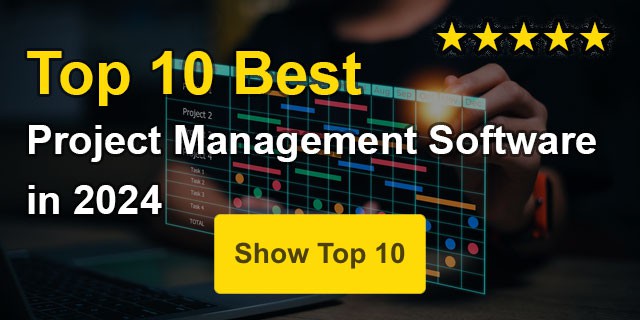Best Meeting Minutes Software for Project Managers
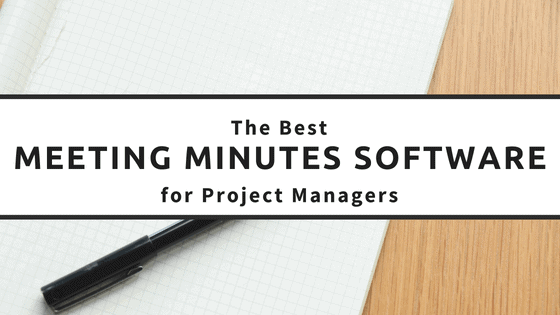
Meeting minutes are necessary overhead when running an effective meeting. The need to organize a formal agenda, track action items, make decisions, and distribute minutes increases with the meeting’s importance. Managing meeting minutes still creates administrative hassles, such as tracking action items from meeting to meeting or easily retaining or retrieving past meeting minutes. Fortunately, impressive meeting minutes software solutions enable teams to become more effective than the usual juggling act across a Microsoft Word agenda, meeting notices, and a spreadsheet of action items.
If you run a board meeting, executive steering committee, or senior management review, you’ll want a well-organized agenda with meeting minutes. Meeting-minute software is not likely needed if you run a short 15-minute standup. However, if you manage a lot of meetings, these four excellent meeting-minute software solutions will help manage the administrative hassle and improve communication.
4 Meeting Minutes Tools for Your Team
While searching for meeting minute software, I sought web-based solutions, supported agenda collaboration, maintained a historical repository, and kept a log of ongoing action items. The five applications that met my criteria included:
Many software solutions are available for meeting minutes, including Microsoft Word, OneNote, Google Docs, Evernote, and other individual tools. Many new solutions are incorporating AI models into their software. This article focuses on web-based solutions that keep all attendees informed without searching the email or ensuring the latest amended notes are on a shared drive. Let’s dive into each of the four applications.
#1. Beenote
Beenote offers meeting management solutions for boards, committees, and project teams. If your organization has any meeting requiring an agenda, Beenote has it covered with a wide range of functionality and an easy-to-use application. They have successfully engineered a solution that works well for a structured, formal meeting and a more dynamic, less formatted meeting where notes and actions are still required.
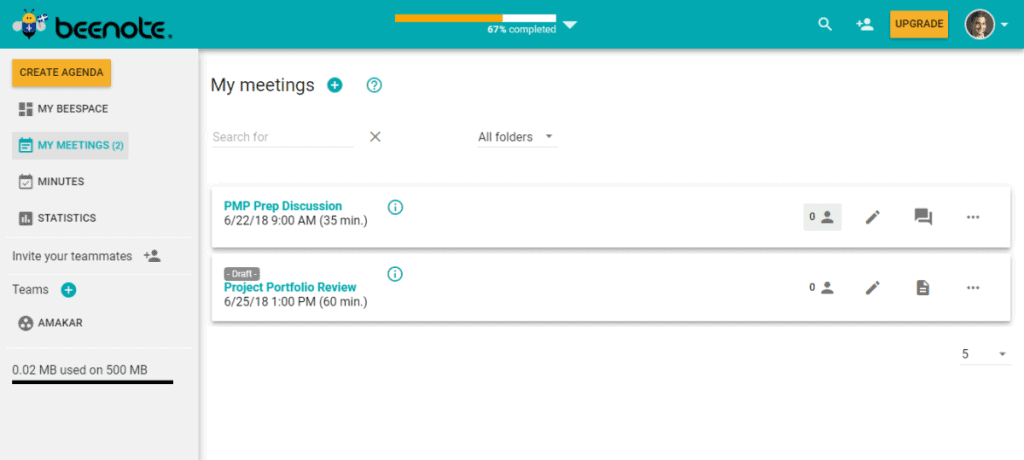
Beenote has a ton of features, including:
- Full integration with Microsoft 365 ( web and Outlook) and Google Calendar for meeting scheduling and task follow-up
- Agenda planning with draft and approval mode so your team can collaborate on essential agendas
- Objectives are assigned to each agenda item to inform, exchange views, generate ideas, consult or decide
- Voice recording of meeting all or part
- Visible and audible Automatic Timekeeper per subject and meeting overall
- Real-time sharing of notetaking
- Link to a URL and files accessible per subject
- Minutes can be completed during the meeting
- Notes, task, and decision support per subject
- Statistical data available for the administrators
- Search functionality for all meeting
- Minutes can be viewed by all, limited to a team or the participants
- Support multiple viewers, PCs, tablets, and mobile in both Android, iOS, and native web formats
I liked how objectives were assigned to each agenda topic and how notes, decisions, and tasks were easily created under each agenda topic. In agenda planning, meeting organizers often list the items for discussion without clarifying the outcome of the specific agenda topic. Including the objective with each agenda item is a nice feature that rounds the agenda.
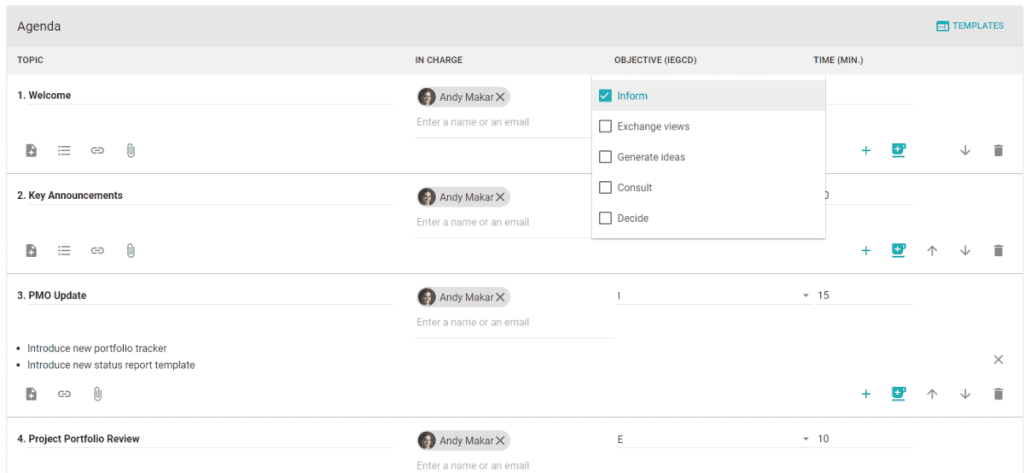
In Beenote, each agenda item can have multiple notes, decisions, and tasks created during the meeting. The meeting minute software is straightforward to use, and reordering individual elements is a click away. Tasks are assigned to meeting participants, and each person’s tasks appear on their dashboard.

Beenote also has an innovative voice recording feature that allows the meeting scribe to record a segment of the discussion or the entire agenda item discussion. If you ever had to be the scribe in the meeting, this feature will save you from being overwhelmed with “who said what” during those active discussions.
After the meeting, the organizer can adjust notes, tasks, or decisions before publishing and distributing the minutes to the attendees. Unpublished minutes can be edited, but once published, they can not be edited again. If published minutes need to be revised, the meeting owner can unpublish them and make the appropriate edits.
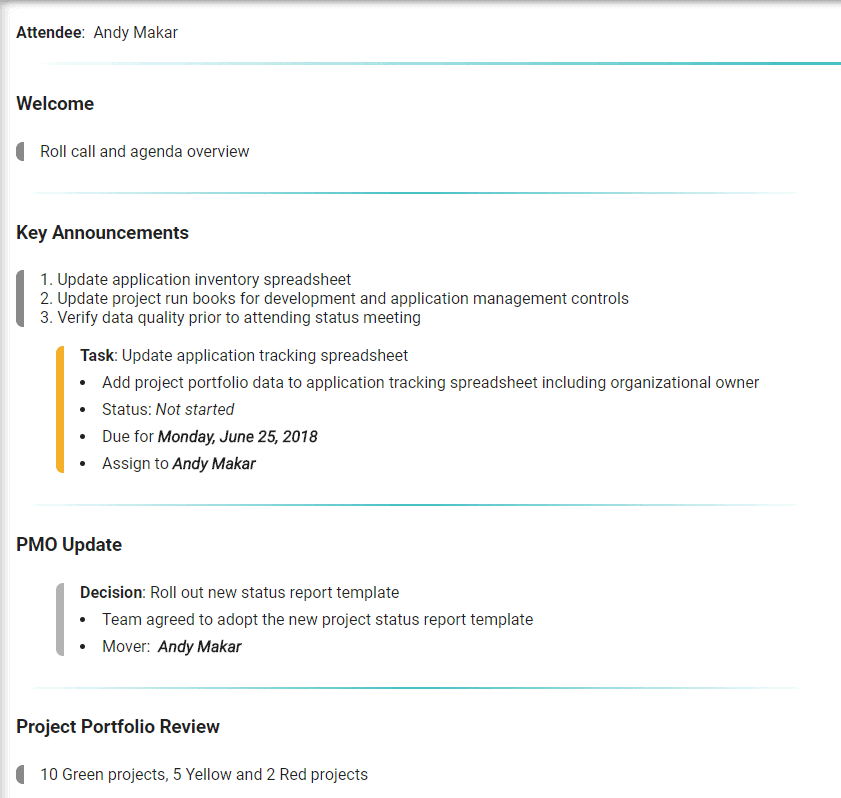
Once tasks are created, the project manager in me wouldn’t be satisfied unless I could track the open tasks and overall statistics. Beenote provides a nice set of statistics for attendance, meetings, and task tracking.
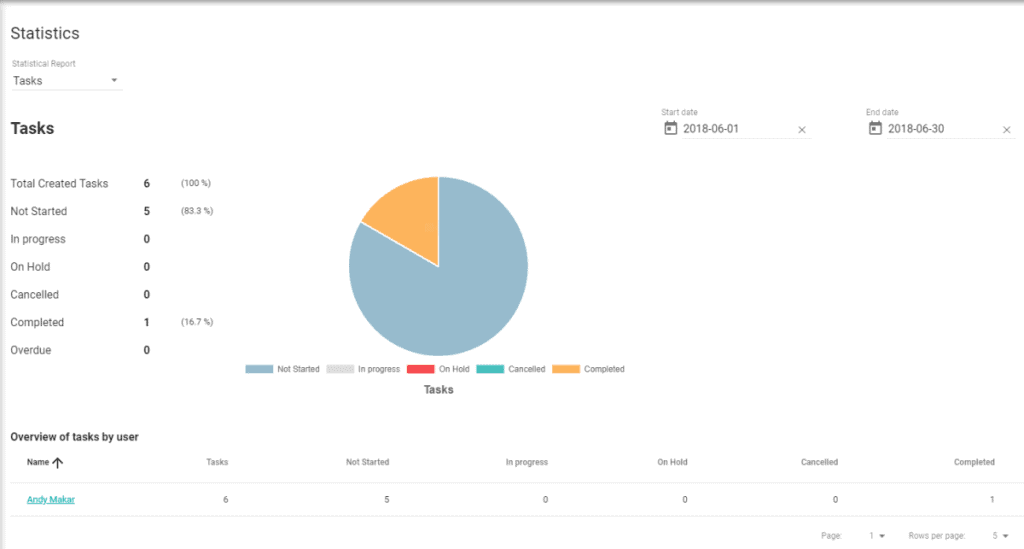
I found Beenote easy to use and helpful in organizing decisions and discussion items for my next steering committee meeting.
#2. MeetingBooster
MeetingBooster is an enterprise meeting management solution offering cloud and on-premise software installations. MeetingBooster reminds me of a classic Windows Ribbon application optimized for enterprise meeting management. It has many meeting minutes features, including:
- Integration with Outlook Calendar, Tasks, and Google Calendar
- Flexible agenda and task module
- Project organization enabling meeting tasks to be assigned to specific projects
- Meeting attendance tracking
- Agenda and meeting minutes approval process
- Searchable database of meeting minutes
- Voting, pro/con, and item rating tools to facilitate voting
- Permission System with Security Roles
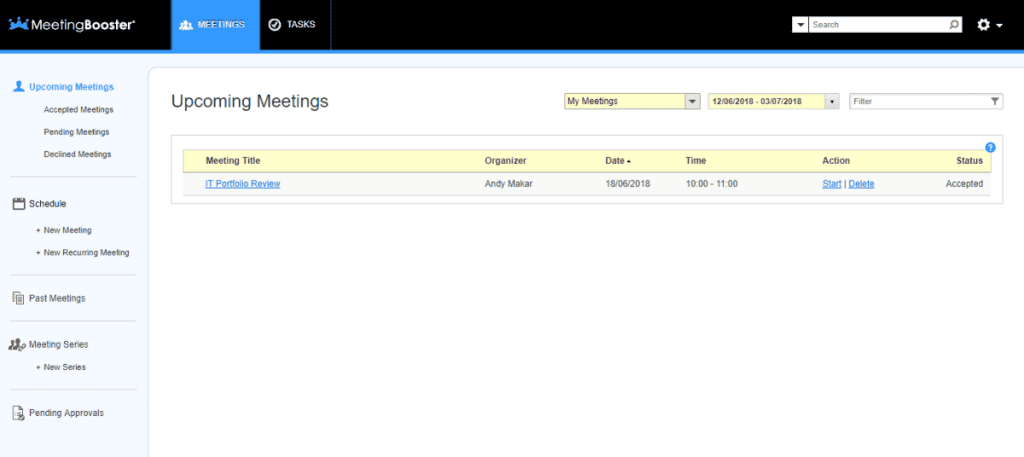
MeetingBooster has a process focus that facilitates a better meeting. The first action is to conduct the roll call when the meeting starts. In other applications, this is an optional step. I found this feature helpful as it is usually an administrative step often skipped.
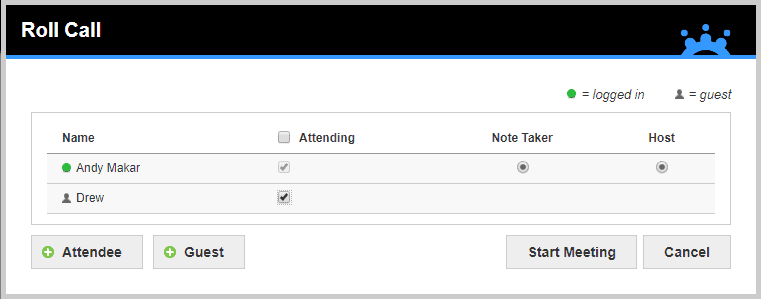
Adding agenda items is easy. Moving or indenting agenda items can be accomplished by dragging and dropping them. Tasks can also be created as part of the meeting agenda and during the meeting.
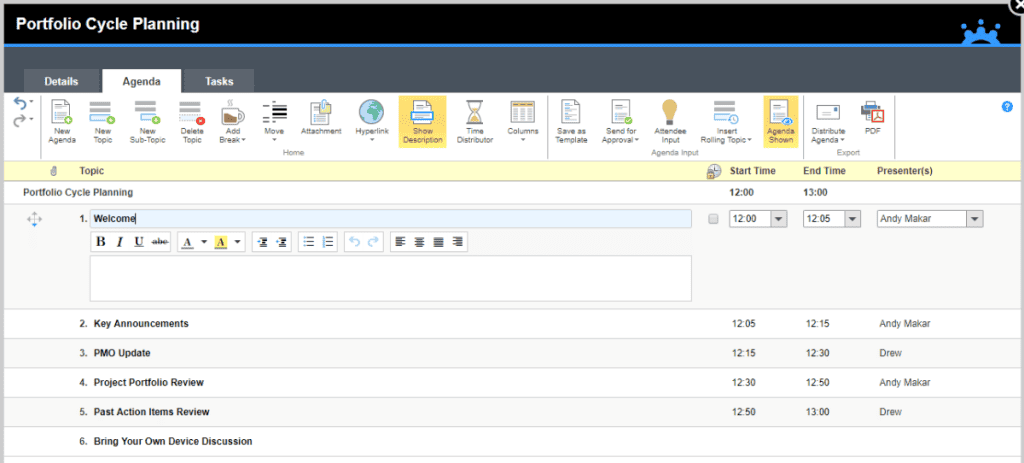
During the meeting, team members can vote on agenda items, identify a list of pros/cons for decision-making, and rate ideas in a collaborative, online agenda. These features help teams make and record decisions instead of manually counting responses.
After the meeting ends, the meeting minutes are generated, and the organizer can edit and amend them before distributing them to the team. The minutes are published in a professional-looking format that captures the activities conducted in the meeting. I liked being able to edit the minutes in the meeting minute format, as the meeting organizer or scribe may want to edit or summarize the notes and decisions.
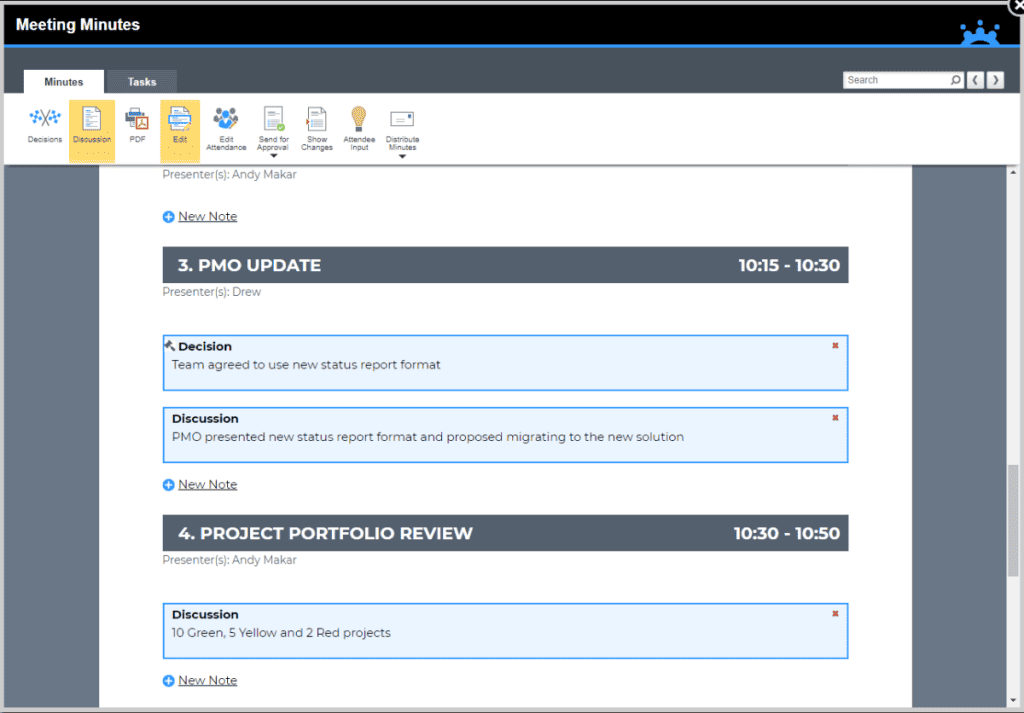
Another helpful feature is MeetingBooster’s task organization by project. Meetings are the “bread and butter” of project management work. Organizing conferences and tasks against specific projects allows the project manager or program manager to view all the outstanding action items from the relevant meetings. The entire meeting minute database is searchable, so finding the tasks or the relevant nuggets from a few meetings ago is easy.
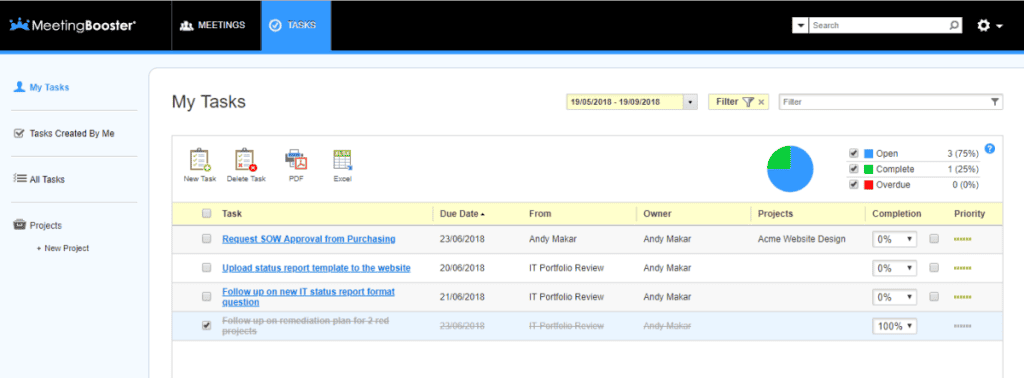
#3. MeetingKing
After reviewing four of these meeting minutes software solutions, I’ve seen a lot of functional overlap; however, each software solution implements the features differently. MeetingKing provides features similar to the other three solutions, as meetings are created and collaborated with actions, notes, and decisions tracked during and after each meeting. MeetingKing provides a structured format for tracking agenda items and a free-form view for more flexibility.

MeetingKing easily supports agenda creation, task tracking, decisions, and meeting minutes. It has also implemented the Parking Lot feature to help keep the meeting focused and on track. In meetings, new topics can derail the original intent. Using the Parking Lot feature, you can postpone that agenda item but keep track of it for future discussions.
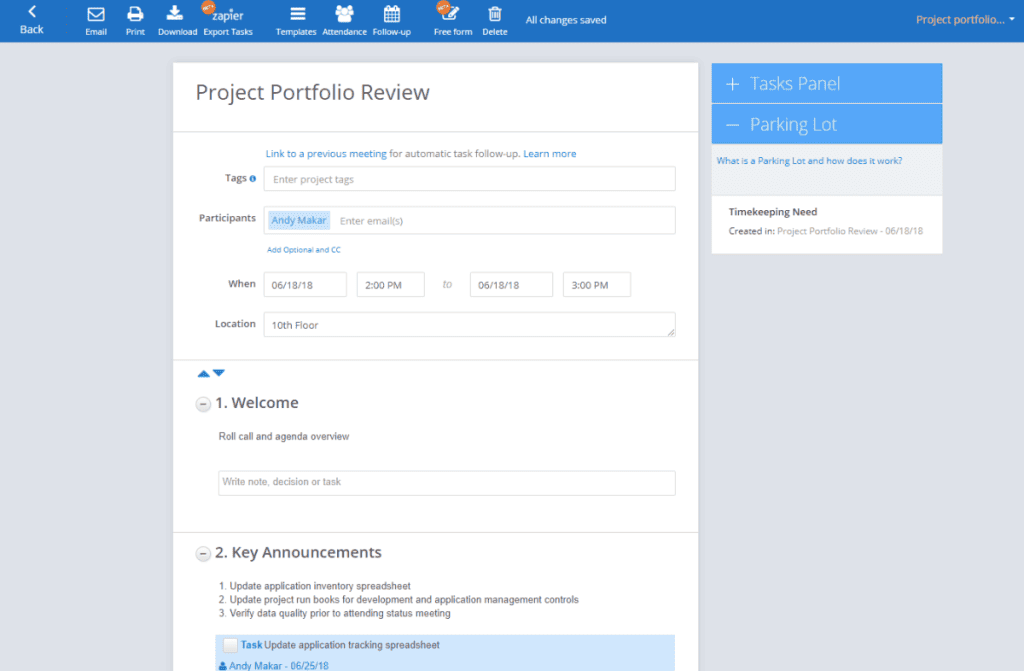
By establishing a parking lot, the requestor still feels acknowledged and can follow up on parking lot items for future action. Without a parking lot, the requestor could become a disruptor if the agenda item is not acknowledged. Other meeting-minute software tools also provide this functionality, but I thought MeetingKing implemented it the best.
MeetingKing also efficiently creates tasks, decisions, and notes by ensuring the text is written first. Then, the note-taker can determine whether the note should become a task, decision, or simple note.
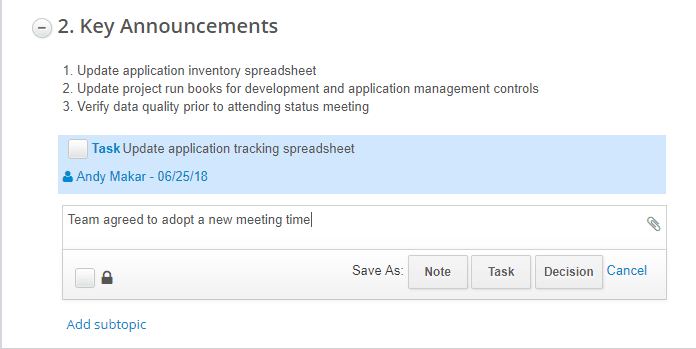
Another innovative feature is the use of a Kanban board to group ideas, to-dos, and completed tasks. The tasks don’t move from column to column like Trello, but clicking on the checkbox will move the task to the Completed column. I found it to be a useful approach to managing a task list for ideas and tasks with due dates.
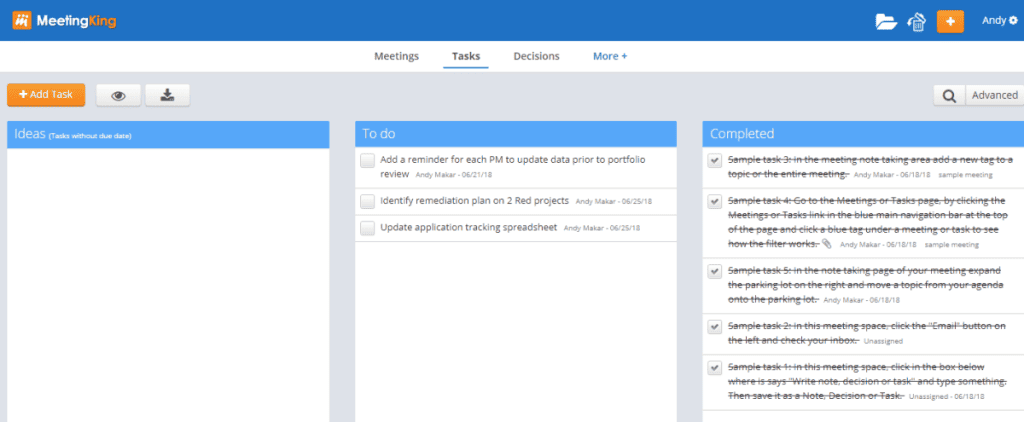
#4. FreJun
FreJun makes meeting minutes even more accessible by taking them for you! It is an artificial intelligence assistant that records phone calls and web conference meetings and provides automated transcripts and notes after the meeting.
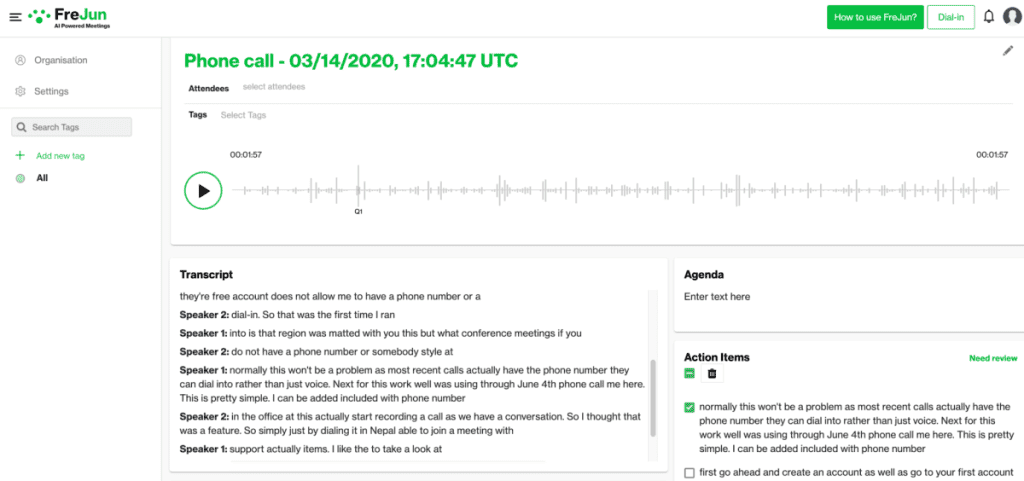
I found FreJun innovative by removing the burden of taking meeting minutes and letting artificial intelligence take over! Once I created an account with FreJun, I started a conference call and added the FreJun agent to the call by adding the FreJun phone number as a caller.
Within a minute of the meeting being completed, the FreJun software notified me that the transcript was available. All the meetings are displayed on the user’s dashboard for easy reference. The software identified the speakers, created a meeting summary, and generated action items based on the conversation.
It is essential to review the transcript, action items, and meeting summary for accuracy and completeness. If additional action items need to be added, the user can highlight the sentence in the transcript, right-click and it will be added to the Action Items. The phone call can be played back and shared with meeting participants.
Key Benefits with FreJun Artificial Intelligence
I’ve participated in many remote conference calls and web-conferencing meetings where team members record the meeting (video and audio) for future reference. Team members also take notes, but getting a transcript in addition to the recorded meeting is beneficial.
The key benefit for project teams is saving time and quickly identifying key actionable insights without having a team member bear the administrative note-taking burden. Meetings often go off-track, and a note-taker may miss an action item. With FreJun, you can quickly scan a transcript and confirm or revise action items.
Easy Integrations
With the increased web-based software solutions, new opportunities exist to integrate these applications with other project management and task-tracking applications. Each meeting minutes application usually has its native integration with Microsoft and Google tools. If project teams need to interact with other 3rd party applications like JIRA and Trello, then Zapier will connect the applications seamlessly.
Zapier is an online automation tool connecting two web-based applications to automate tasks. In Minute, you may want to create a new Trello card for every new Minute task. If a new task is assigned to a user, sending a notification to the user’s Slack account would be helpful. Zapier provides all these integrations with zero coding or developer support.
Minute, MeetingKing, and Beenote all have integrations with Zapier. These integrations are essential as they enable teams to leverage the meeting minutes software and integrate with their chosen project management or collaboration tool.
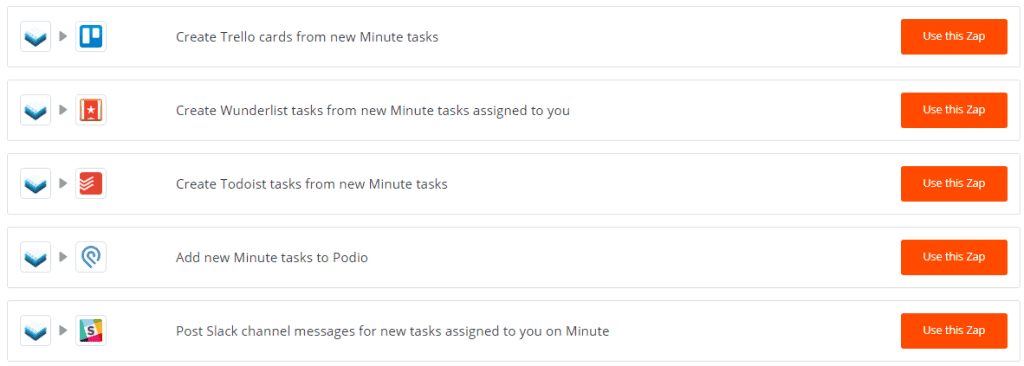
Additional Considerations
Where is your data hosted?
Meeting minutes software will help you manage meetings to dominate your market, but it isn’t helpful if your market is exposed to your plans. As you assess each decision, determine the data sensitivity and risk associated with storing meeting minute data and documents in the cloud. People are embracing the cloud; however, organizations will need assurance on how their data is hosted and protected.
Of the 4 solutions reviewed, MeetingBooster is the only one that offers an on-premise solution that your IT team can install on your company’s servers. However, each of these companies should be able to provide a SOC 2 compliance certificate or comparable proof of secure hosting.
What types of meetings need meeting minutes software?
Meeting minute software will help your organization maximize its efficiency in conducting meetings and documenting the outcomes and action items for subsequent meetings. If you are organizing a board meeting, the need for meeting minutes software increases. However, if you are running your daily stand-up or a quick status meeting, using meeting minute software may be overkill, as the team has other compensating processes.


